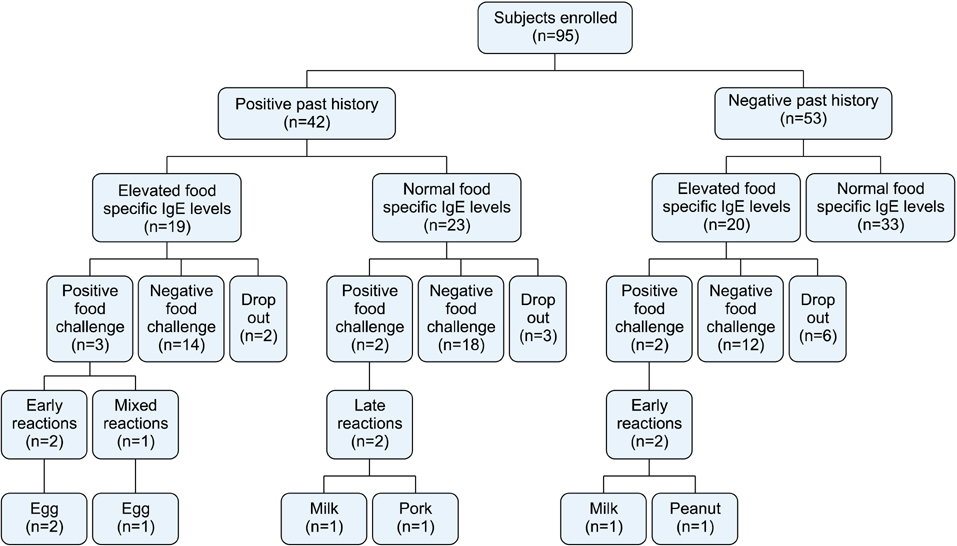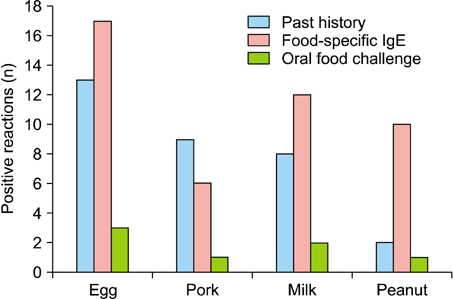Food Hypersensitivity in Patients with Childhood Atopic Dermatitis in Korea
- Affiliations
-
- 1Department of Dermatology, Kangnam Sacred Heart Hospital, College of Medicine, Hallym University, Seoul, Korea. Dermap@paran.com
- KMID: 2171788
- DOI: http://doi.org/10.5021/ad.2013.25.2.196
Abstract
- BACKGROUND
It is well known that atopic dermatitis (AD) is related to food hypersensitivity, although its prevalence varies among several studies according to age group, severity, country, survey time, and test method.
OBJECTIVE
To examine the prevalence and status of food hypersensitivity among childhood AD patients in Korea.
METHODS
A total of 95 patients were enrolled in the study. The history of food hypersensitivity was collected by interviews. The severity of AD was evaluated by eczema area and severity index (EASI). We took blood samples to measure serum total and food-specific immunoglobulin E (IgE) levels. Based on the histories and serum IgE levels, open oral food challenge (OFC) testing was performed to confirm food hypersensitivity.
RESULTS
Forty-two (44.2%) of the 95 AD patients had histories of food hypersensitivity. They reported that the most common suspicious foods were egg (n=13, 13.7%), pork (n=9, 9.5%) and cow milk (n=8, 8.4%). The mean EASI score was 16.05+/-9.76. Thirty-nine (41.1%) of the 95 patients showed elevated serum food-specific IgE levels. The specific IgE levels were elevated for egg (n=17, 17.9%), milk (n=12, 12.6%), peanut (n=10, 10.5%) and wheat (n=8, 8.4%). Fifty-one (53.8%) of 95 patients underwent open OFC, and only 7 (13.7%) of these patients showed positive reactions.
CONCLUSION
The overall prevalence of food hypersensitivity in patients with childhood AD in Korea was 8.3% (7/84). The most common foods causing food hypersensitivity were egg and milk. Among the foods causing hypersensitivity, AD patients in Korea often underestimated peanut, while they overestimated pork.
MeSH Terms
Figure
Cited by 3 articles
-
Food Allergy in Korean Patients with Chronic Urticaria
Bo Young Chung, Yong Se Cho, Hye One Kim, Chun Wook Park
Ann Dermatol. 2016;28(5):562-568. doi: 10.5021/ad.2016.28.5.562.The investigation of hypoproteinemia in pediatric atopic dermatitis
Jong Ha Park, Yonghye Shin, Geun Hwa Park, Sung Won Kim
Allergy Asthma Respir Dis. 2013;1(4):344-349. doi: 10.4168/aard.2013.1.4.344.Age-Based Causes and Clinical Characteristics of Immediate-Type Food Allergy in Korean Children
Kyunguk Jeong, Jihyun Kim, Kangmo Ahn, So-Yeon Lee, Taek Ki Min, Bok Yang Pyun, Yoon Hee Kim, Kyung Won Kim, Myung Hyun Sohn, Kyu-Earn Kim, Gwang Cheon Jang, Tae-Won Song, Jung Hee Kim, You Hoon Jeon, Yong Ju Lee, Yong Mean Park, Hye Yung Yum, Hyun Hee Kim, Woo Kyung Kim, Sooyoung Lee
Allergy Asthma Immunol Res. 2017;9(5):423-430. doi: 10.4168/aair.2017.9.5.423.
Reference
-
1. Kim JY, Lim HJ, Kim HY, Lee WK, Kim BS, Lee WJ, et al. Difference in the prevalence rate according to diagnostic criteria in atopic dermatitis: prevalence rate of atopic dermatitis according to Hanifin-Rajka, Japanese, Korean diagnostic criteria and characteristics of three different diagnostic criteria. Korean J Dermatol. 2010. 48:649–656.2. Hahn EL, Bacharier LB. The atopic march: the pattern of allergic disease development in childhood. Immunol Allergy Clin North Am. 2005. 25:231–246.
Article3. Schloss OM. Allergy to common foods. Trans Am Pediatr Soc. 1915. 27:62–68.4. Greenhawt M. The role of food allergy in atopic dermatitis. Allergy Asthma Proc. 2010. 31:392–397.
Article5. Rowlands D, Tofte SJ, Hanifin JM. Does food allergy cause atopic dermatitis? Food challenge testing to dissociate eczematous from immediate reactions. Dermatol Ther. 2006. 19:97–103.
Article6. Campbell DE. Role of food allergy in childhood atopic dermatitis. J Paediatr Child Health. 2012. 48:1058–1064.
Article7. Oh JW, Pyun BY, Choung JT, Ahn KM, Kim CH, Song SW, et al. Epidemiological change of atopic dermatitis and food allergy in school-aged children in Korea between 1995 and 2000. J Korean Med Sci. 2004. 19:716–723.
Article8. Jeon HJ, Bang HD, Kim KH, Park CW, Kim KJ, Lee CH. A Study of food allergy in atopic dermatitis using CAP-RAST FEIA and open food challenge test. Korean J Dermatol. 2003. 41:1034–1040.9. Park YL, Kim HD, Kim KH, Kim MN, Kim JW, Ro YS, et al. Report from ADRG: a study on the diagnostic criteria of Korean atopic dermatitis. Korean J Dermatol. 2006. 44:659–663.10. Nowak-Wegrzyn A, Assa'ad AH, Bahna SL, Bock SA, Sicherer SH, Teuber SS. Adverse Reactions to Food Committee of American Academy of Allergy, Asthma & Immunology. Work Group report: oral food challenge testing. J Allergy Clin Immunol. 2009. 123:S365–S383.11. Rancé F. Food allergy in children suffering from atopic eczema. Pediatr Allergy Immunol. 2008. 19:279–284.
Article12. Uenishi T, Sugiura H, Tanaka T, Uehara M. Role of foods in irregular aggravation of skin lesions in children with atopic dermatitis. J Dermatol. 2008. 35:407–412.
Article13. Suh KY. Food allergy and atopic dermatitis: separating fact from fiction. Semin Cutan Med Surg. 2010. 29:72–78.
Article14. Werfel T, Ballmer-Weber B, Eigenmann PA, Niggemann B, Rancé F, Turjanmaa K, et al. Eczematous reactions to food in atopic eczema: position paper of the EAACI and GA2LEN. Allergy. 2007. 62:723–728.
Article15. Abernathy-Carver KJ, Sampson HA, Picker LJ, Leung DY. Milk-induced eczema is associated with the expansion of T cells expressing cutaneous lymphocyte antigen. J Clin Invest. 1995. 95:913–918.
Article16. Worm M, Ehlers I, Sterry W, Zuberbier T. Clinical relevance of food additives in adult patients with atopic dermatitis. Clin Exp Allergy. 2000. 30:407–414.
Article17. Celik-Bilgili S, Mehl A, Verstege A, Staden U, Nocon M, Beyer K, et al. The predictive value of specific immunoglobulin E levels in serum for the outcome of oral food challenges. Clin Exp Allergy. 2005. 35:268–273.
Article18. Roehr CC, Reibel S, Ziegert M, Sommerfeld C, Wahn U, Niggemann B. Atopy patch tests, together with determination of specific IgE levels, reduce the need for oral food challenges in children with atopic dermatitis. J Allergy Clin Immunol. 2001. 107:548–553.
Article19. Eigenmann PA, Calza AM. Diagnosis of IgE-mediated food allergy among Swiss children with atopic dermatitis. Pediatr Allergy Immunol. 2000. 11:95–100.
Article20. Roehr CC, Edenharter G, Reimann S, Ehlers I, Worm M, Zuberbier T, et al. Food allergy and non-allergic food hypersensitivity in children and adolescents. Clin Exp Allergy. 2004. 34:1534–1541.
Article21. Sicherer SH, Sampson HA. Food hypersensitivity and atopic dermatitis: pathophysiology, epidemiology, diagnosis, and management. J Allergy Clin Immunol. 1999. 104:S114–S122.
Article22. de Benedictis FM, Franceschini F, Hill D, Naspitz C, Simons FE, Wahn U, et al. EPAAC Study Group. The allergic sensitization in infants with atopic eczema from different countries. Allergy. 2009. 64:295–303.
Article23. Sicherer SH, Sampson HA. Food allergy. J Allergy Clin Immunol. 2010. 125:S116–S125.
Article24. Sicherer SH, Sampson HA. Peanut allergy: emerging concepts and approaches for an apparent epidemic. J Allergy Clin Immunol. 2007. 120:491–503.
Article25. Han YS, Chung SJ, Cho YY, Choi HM, Ahn KM, Lee SI. Analysis of the rate of sensitization to food allergen in children with atopic dermatitis. Korean J Community Nutr. 2004. 9:90–97.26. Sinagra JL, Bordignon V, Ferraro C, Cristaudo A, Di Rocco M, Amorosi B, et al. Unnecessary milk elimination diets in children with atopic dermatitis. Pediatr Dermatol. 2007. 24:1–6.
Article



